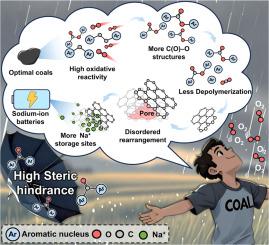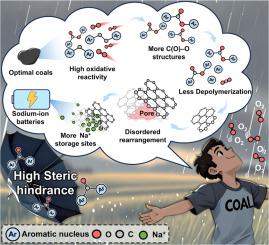Reducing steric hindrance to enhance the oxidation reactivity of coal precursors for high-performance hard carbons in sodium-ion batteries
IF 20.2
1区 材料科学
Q1 CHEMISTRY, PHYSICAL
引用次数: 0
Abstract
The effective introduction of oxygen during pre-oxidation has been proved to be a prerequisite for producing coal-derived hard carbons in sodium-ion batteries. However, the influences of inherent oxygen functional groups within coal on its oxidation and pyrolysis behaviors are still underexplored due to the highly complex compositions of coal. Here, based on the molecular dipole moments, coal components with different oxygen-containing functional groups are separated to synthesize distinct hard carbons. Experimental and theoretical analyses demonstrate that small bond angle C=O groups endow carbonyl-rich coal components with high steric hindrance and thermal stability, limiting their oxidation reactivity. After removing these inert components, the oxidation reactivity of coal precursor is significantly enhanced, thereby introducing more C(O)–O groups during pre-oxidation. These C(O)–O groups elevate adjacent C–C bond energies, which not only mitigate the depolymerization of coal macromolecules but also prevent the thermal slip of carbon layers, facilitating the formation of closed micropores. Thus, the obtained coal-derived hard carbons achieve a high reversible capacity of 329 mAh/g and excellent kinetic performance. This study highlights the critical role of inherent oxygen functional groups of precursors in modulating oxidation reactivity, providing a rational precursor design guideline for high-performance coal-derived hard carbons.


降低位阻以提高钠离子电池中高性能硬碳煤前驱体的氧化反应活性
预氧化过程中氧的有效引入已被证明是生产钠离子电池中煤衍生硬碳的先决条件。然而,由于煤的成分非常复杂,煤中固有氧官能团对其氧化热解行为的影响尚未得到充分的研究。在这里,基于分子偶极矩,分离具有不同含氧官能团的煤组分,合成不同的硬碳。实验和理论分析表明,小键角C=O基团使富羰基煤组分具有较高的位阻和热稳定性,限制了它们的氧化反应活性。去除这些惰性成分后,煤前驱体的氧化反应活性显著增强,从而在预氧化过程中引入更多的C(O) -O基团。这些C(O) -O基团提高了相邻的C - C键能,既减缓了煤大分子的解聚,又防止了碳层的热滑移,有利于封闭微孔的形成。因此,得到的煤衍生硬炭具有329 mAh/g的高可逆容量和优异的动力学性能。本研究突出了前驱体中固有氧官能团在调节氧化反应性中的关键作用,为高性能煤系硬碳前驱体设计提供了合理的指导。
本文章由计算机程序翻译,如有差异,请以英文原文为准。
求助全文
约1分钟内获得全文
求助全文
来源期刊

Energy Storage Materials
Materials Science-General Materials Science
CiteScore
33.00
自引率
5.90%
发文量
652
审稿时长
27 days
期刊介绍:
Energy Storage Materials is a global interdisciplinary journal dedicated to sharing scientific and technological advancements in materials and devices for advanced energy storage and related energy conversion, such as in metal-O2 batteries. The journal features comprehensive research articles, including full papers and short communications, as well as authoritative feature articles and reviews by leading experts in the field.
Energy Storage Materials covers a wide range of topics, including the synthesis, fabrication, structure, properties, performance, and technological applications of energy storage materials. Additionally, the journal explores strategies, policies, and developments in the field of energy storage materials and devices for sustainable energy.
Published papers are selected based on their scientific and technological significance, their ability to provide valuable new knowledge, and their relevance to the international research community.
 求助内容:
求助内容: 应助结果提醒方式:
应助结果提醒方式:


